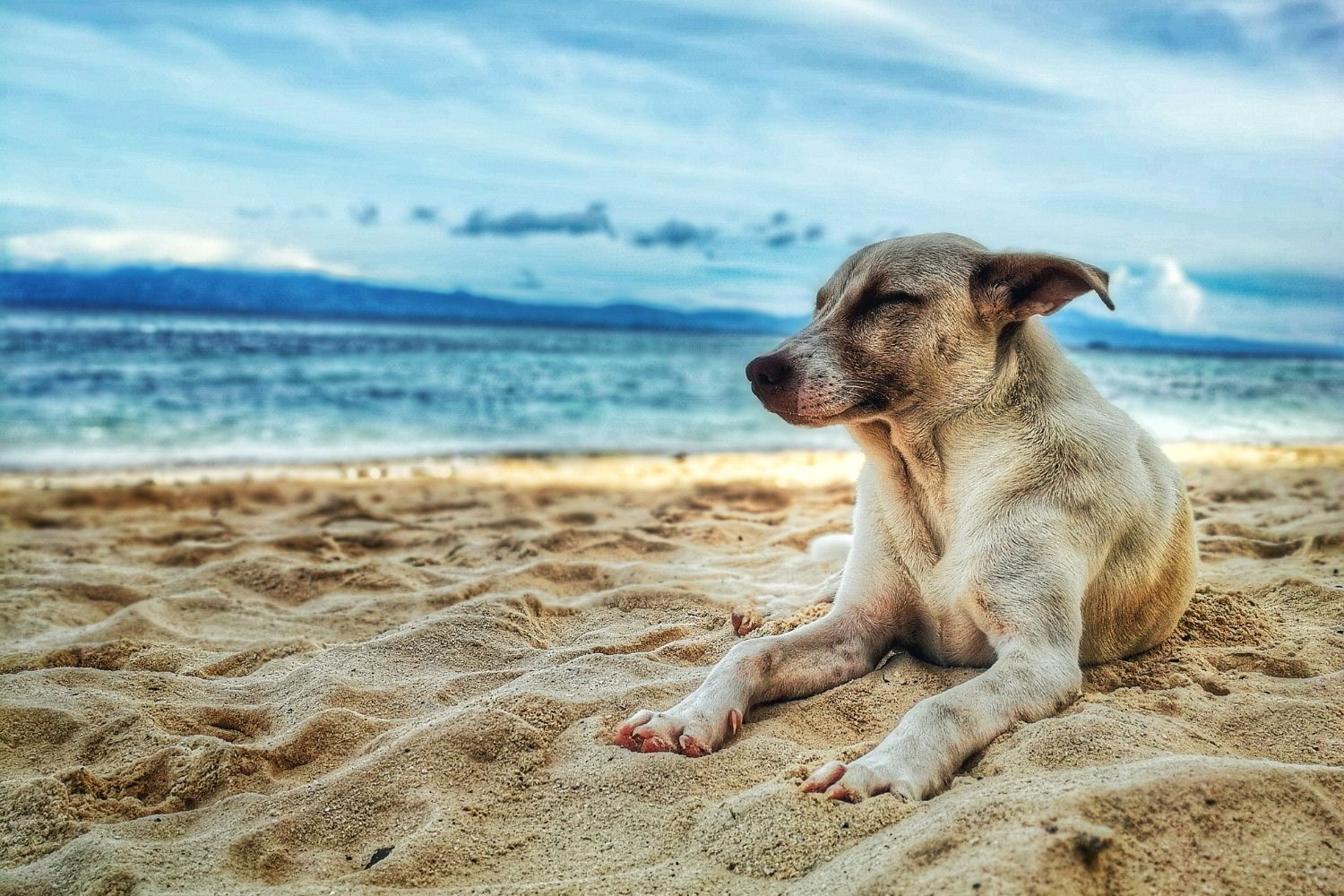Sean McCormack, head vet at dog food specialist tails.com, shares his top tips for keeping you and your dog safe.

Beware of hot sand
Sand can become extremely hot and reach dangerous temperatures during the summer months. Your dog’s sensitive paw pads could easily burn when playing in the sand.
Wherever possible, keep your dog from walking on sand that’s exposed to the direct sun, and monitor your pet’s paw pads for signs of burning, such as redness, blisters, and swelling.
The beach is no place for your four-legged friend when the temperature is high. Try to beat the heat and visit before 9am or after 6pm. And always check the sand and ground temperature before allowing your dog to run, walk, or play.”
Stop your pup from eating sand
Sand is unavoidable when visiting the beach, and, believe it or not, some dogs are known to eat sand — mostly by accident, but some pups do it purposefully. Swallowing sand is extremely dangerous for dogs as it can cause a blockage in the intestine, which is called sand impaction.
If your dog is vomiting, showing signs of constipation, has abdominal pain, reduced appetite, or is lethargic after a trip to the beach, this may indicate that a large amount of sand has been ingested. If you notice that your dog is displaying any of these symptoms, consult a veterinarian immediately.
When at the beach, keep a close eye on your pup and prevent them from eating any sand and bring water to clear toys of large clumps of sand.
Provide shade
A fun day at the beach can turn into a disaster if you don’t take the correct precautions. For your dog, heatstroke can develop quickly, especially when shade isn’t provided. Our furry friends can’t handle the hot temperatures like us humans because they only have sweat glands in their feet and nose, which are less efficient at cooling themselves down.
Make sure you provide shade to get your dog out of the sun quickly. We recommend a pop-up beach tent, beach umbrella, or a small beach canopy. If you see your dog panting and drooling excessively, and their gums have become more red than normal, they could be experiencing heatstroke. In this case, you’ll need to get out of the sun and cool your dog down.
Bring plenty of fresh water
Dogs love the beach, but playing fetch, jumping the waves, and swimming can all lead to a very thirsty dog. When our furry friends are thirsty, they will almost drink anything — and this includes sea water.
Salt water consumed in small quantities is usually not harmful and may only cause diarrhoea, but drinking larger amounts can disrupt the fluid balance in your dog’s body, and high levels of salt can be fatal for your dog. It’s essential when heading to the beach to bring a dog bowl and fresh water for your pup to drink.
Pack dog-friendly sunscreen
Just like us, dogs can quickly get burned from sun exposure. This is particularly common on parts of the body that are sparsely covered with hair. Sunburn can not only cause pain for your four-legged friend but can lead to more severe health problems, such as skin cancer.
Dogs that typically have thin hair or light coloured coats are more vulnerable to sunburn, for example; Dalmatians, Boxers, Greyhounds, Beagles, Whippets and Bulldogs. But all dog breeds are at risk of sun damage because they all have areas on their body where there is little to no fur, including the belly, ears, the tip of the tail and nose.
Before heading to the beach, find a sunscreen that is designed to protect your pup. It’s vital that you only use formulas that have been produced for dogs — they should not contain zinc oxide or para-aminobenzoic acid.
Protect your pups from parasites
A day at the beach is the perfect way to get some fresh air and relax. But as you search for the ideal location to lay down your towel, you should know you’re not just sharing the beach with fellow ocean lovers — you’ll be sharing it with some creepy parasites too.
Ticks are prevalent near beaches. They can be found in the dunes or in the grass nearby, and when our canine companions walk by and brush up against these, the ticks dislodge. Before heading on your journey, remember to pack a tick remover tool.
Keep them safe in the water
Your dog may be a confident swimmer, but big waves and strong tides can be hazardous. Bring along an extended leash so your pup can take a dip in the sea without going too far, and purchase a dog-friendly life jacket to ensure their safety at all times.
The sea is full of hidden dangers, from sharp shells and rocks to broken glass and washed-up rubbish. All of these items can be dangerous to your dog’s paw pads. Not only can some of the items be sharp and cut your pup, but they can also be dangerous if eaten. They can cause bacterial infections, cracked teeth or intestinal obstructions. Protect your pooch by investing in some dog-friendly beach boots and never leave them unattended in the water or on dry land.
Keep clear of seaweed and sea creatures
Natural objects found in the sea that wash up on the beach, such as seaweed, dead or alive creatures, might be fun to play with, but could cause serious health issues for your dog. When consumed, seaweed can be dangerous as it can cause a blockage in your dog’s intestine.
Keep a close eye on your pup and prevent them from rolling in or eating anything that could make them ill. Some beaches have high levels of sea creatures, such as jellyfish and crabs, so be sure to keep them on a tight watch around the water area.
It’s really important as dog owners that we don’t allow our dogs to chase or disturb marine wildlife, for example, seal pups and marine birds can be prone to be disturbed by dogs. Our wild animals are just as important as our pets so it’s important to be responsible around wildlife.



